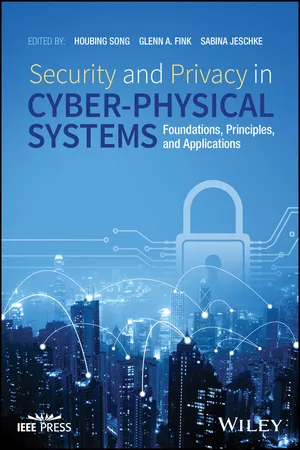
Security and Privacy in Cyber-Physical Systems
Foundations, Principles, and Applications
- English
- ePUB (mobile friendly)
- Available on iOS & Android
Security and Privacy in Cyber-Physical Systems
Foundations, Principles, and Applications
About this book
Written by a team of experts at the forefront of the cyber-physical systems (CPS) revolution, this book provides an in-depth look at security and privacy, two of the most critical challenges facing both the CPS research and development community and ICT professionals. It explores, in depth, the key technical, social, and legal issues at stake, and it provides readers with the information they need to advance research and development in this exciting area.
Cyber-physical systems (CPS) are engineered systems that are built from, and depend upon the seamless integration of computational algorithms and physical components. Advances in CPS will enable capability, adaptability, scalability, resiliency, safety, security, and usability far in excess of what today's simple embedded systems can provide. Just as the Internet revolutionized the way we interact with information, CPS technology has already begun to transform the way people interact with engineered systems. In the years ahead, smart CPS will drive innovation and competition across industry sectors, from agriculture, energy, and transportation, to architecture, healthcare, and manufacturing. A priceless source of practical information and inspiration, Security and Privacy in Cyber-Physical Systems: Foundations, Principles and Applications is certain to have a profound impact on ongoing R&D and education at the confluence of security, privacy, and CPS.
Frequently asked questions
- Essential is ideal for learners and professionals who enjoy exploring a wide range of subjects. Access the Essential Library with 800,000+ trusted titles and best-sellers across business, personal growth, and the humanities. Includes unlimited reading time and Standard Read Aloud voice.
- Complete: Perfect for advanced learners and researchers needing full, unrestricted access. Unlock 1.4M+ books across hundreds of subjects, including academic and specialized titles. The Complete Plan also includes advanced features like Premium Read Aloud and Research Assistant.
Please note we cannot support devices running on iOS 13 and Android 7 or earlier. Learn more about using the app.
Information
Chapter 1
Overview of Security and Privacy in Cyber-Physical Systems
1.1 Introduction
1.2 Defining Security and Privacy
1.2.1 Cybersecurity and Privacy
A condition that results from the establishment and maintenance of protective measures that enable an enterprise to perform its mission or critical functions despite risks posed by threats to its use of information systems. Protective measures may involve a combination of deterrence, avoidance, prevention, detection, recovery, and correction that should form part of the enterprise's risk management approach.(Kissel, 2013, p. 94).
- Confidentiality – Only authorized parties can access computer-related assets.
- Integrity – Assets can be modified only by authorized parties or only in authorized ways.
- Availability – Assets are accessible to authorized parties at appropriate times.
- Authentication – Verifies the identity, often as a prerequisite to access (Committee on National Security Systems, 2010).
- Nonrepudiation – Protects against an individual's false denial of having performed a particular action and captures whether a user performed particular actions (i.e., sending or receiving a message) (NIST, 2013).
1.2.2 Physical Security and Privacy
- Deterrence – A credible threat of countermeasures that prevents actions against the system by making the perceived cost of an attack outweigh the perceived benefits.
- Detection – The positive assessment that a specific object caused the alarm and/or the announcement of a potential malevolent act through alarms.
- Delay – Impediments that slow or prevent an adversary from accessing a protected asset or from completing a malevolent act.
- Response – Actions taken with appropriate force and at locations and times designed to stop the advancement of the adversary.
- Neutralization – Rendering enemy forces incapable of interfering with a particular operation.
1.3 Defining Cyber-Physical Systems
Table of contents
- Cover
- Title Page
- Copyright
- Table of Contents
- List of Contributors
- Foreword
- Preface
- Acknowledgments
- Chapter 1: Overview of Security and Privacy in Cyber-Physical Systems
- Chapter 2: Network Security and Privacy for Cyber-Physical Systems
- Chapter 3: Tutorial on Information Theoretic Metrics Quantifying Privacy in Cyber-Physical Systems
- Chapter 4: Cyber-Physical Systems and National Security Concerns
- Chapter 5: Legal Considerations of Cyber-Physical Systems and the Internet of Things
- Chapter 6: Key Management in CPSs
- Chapter 7: Secure Registration and Remote Attestation of IoT Devices Joining the Cloud: The Stack4Things Case of Study
- Chapter 8: Context Awareness for Adaptive Access Control Management in IoT Environments
- Chapter 9: Data Privacy Issues in Distributed Security Monitoring Systems
- Chapter 10: Privacy Protection for Cloud-Based Robotic Networks
- Chapter 11: Toward Network Coding for Cyber-Physical Systems: Security Challenges and Applications
- Chapter 12: Lightweight Crypto and Security
- Chapter 13: Cyber-Physical Vulnerabilities of Wireless Sensor Networks in Smart Cities
- Chapter 14: Detecting Data Integrity Attacks in Smart Grid
- Chapter 15: Data Security and Privacy in Cyber-Physical Systems for Healthcare
- Chapter 16: Cyber Security of Smart Buildings
- Chapter 17: The Internet of Postal Things: Making the Postal Infrastructure Smarter
- Chapter 18: Security and Privacy Issues in the Internet of Cows
- Chapter 19: Admission Control-Based Load Protection in the Smart Grid
- Editor Biographies
- Index
- End User License Agreement